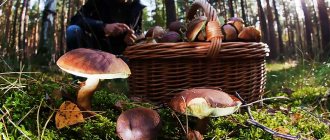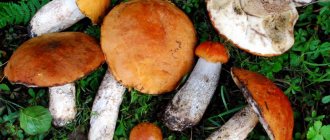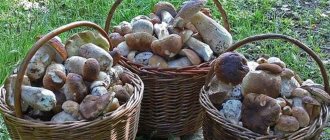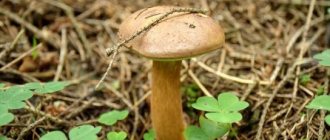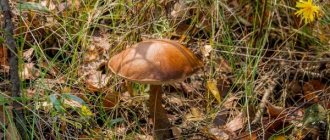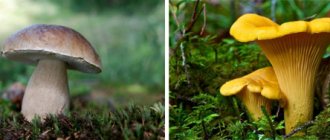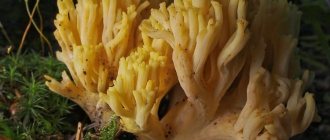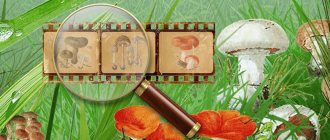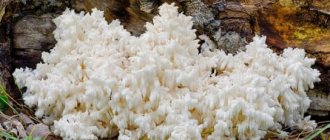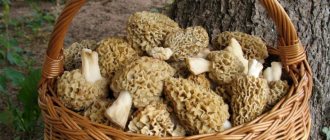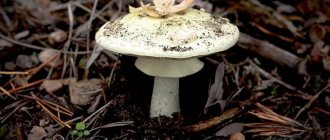Mushrooms are a wonderful culinary product, successfully used to prepare various dishes. The most popular champignons are mushrooms with a white cap and a white stem. However, almost all species have doubles, so you need to be able to distinguish edible mushrooms from inedible, poisonous ones.
The main types of mushrooms, which are based on the criterion of edibility, include:
- edible;
- conditionally edible;
- inedible.
Let us dwell on representatives of these species in more detail.
Edible agaric mushrooms
This group of mushrooms includes tasty, edible representatives that have a lamellar structure under the cap. The spores mature in thin plates under the cap. Their shape and color can be varied, it all depends on the type of mushroom. The variety is distinguished by its elasticity, excellent for salting and pickling.
Real breast milk (edible in the Russian Federation, conditionally edible in the world)
A milkweed belonging to the edible species of the Russula family. The cap is from 5 to 20 cm, flat or funnel-shaped. The coating is slimy. The color is white or yellowish, sometimes cream. The pulp is dense and elastic. The plates are wide and frequent.
Loves deciduous and mixed forests, sandstone. It grows in groups from July to September. Suitable for salting and marinating.
Dry milk mushroom (White load)
Another name is white milk mushroom, since it is not a real milk mushroom, but a russula. The cap is 5-18 cm in diameter. The plates are frequent and run slightly down the stem. The pulp is firm, white, slightly spicy in taste. Considered edible, but little appreciated due to its bland taste.
Loves the edges of coniferous, deciduous or mixed forests. Grows in bushes, on sandstone, near reservoirs (in river channels).
Russula yellow
The correct name is light yellow russula. The cap varies from 3 to 12 cm. While the mushroom is small, it is spherical, and as it grows it becomes convex. Yellow color. The pulp is elastic, hard, white, with a floral aroma.
Often enters into symbiosis with birch. Grows in wetlands, loves moisture and freshness.
Russula lumpy azure
Purple russula with a convex dark tubercle in the center of the cap. Sizes 3-12 cm in diameter. The color comes in a wine shade. The plates are branched and frequent. The pulp is white, turns gray when broken, and has a sweet and fruity taste. It grows in coniferous forests, but prefers pine.
Green russula
A porcini mushroom with a slight swampy tint on the cap. Size – 4-14 cm in diameter. The color is grassy-light green, sometimes slightly yellowish. The pulp is white or light yellowish. The plates are frequent and very fragile.
Grows under a birch tree. Found throughout Europe.
Food russula
Edible mushroom up to 11 cm in diameter. The color is often brown, but purple, pink, and lilac specimens are also found. The mushroom stalk is branched, the plates are frequent.
The pulp is dense, with nutty notes. The most valuable and delicious russula. It grows throughout Russia, often under conifers. Less often prefers oak and beech.
Forked russula
The second name is multi-plate. The cap is up to 12 cm, the main color is green, gray-green or yellow-green. More often it is olive. The top coating of the mushroom is dryish and velvety. The plates are frequent, intertwined at the stem. The pulp is white, turning slightly yellow when exposed to air. There is no smell, the taste is sweet.
The mushroom is edible, the taste is pleasant, without bitterness or pepper. Likes to grow in deciduous forests.
Marsh Russula
A bright representative of Russula. The cap is fleshy, red, darker in the center. The plates are branched, not adherent. The pulp is initially dense and white, becoming loose with age.
Likes to grow in mixed and coniferous forests under larch and cedar. Period – August-September.
Common mistakes
To make sure you don’t pick a bad mushroom, it’s important to know what beginners do wrong during a “quiet hunt.”
Mistakes of beginner mushroom pickers:
- Risk. Professionals have a rule: if there is no accurate information about the mushroom found, it is better not to touch it at all! This is important primarily because one unknown specimen can spoil the whole dish. You cannot collect something that you are not 100 percent sure of.
- Collection near a highway, landfill, near a city, industrial enterprise, railway. The mushroom is a natural scavenger, ready to collect any toxic and chemical compounds.
- Collecting under a tree other than where a particular mushroom usually grows. The find should immediately raise doubts.
- The mushroom picker did not look under his hat. Often poisonous fruits have a lamellar structure, while edible ones are porous or tubular. Sometimes there are exceptions: russula. And again, it’s worth listening to doubts when you come across a mushroom with a lamellar bottom of the cap. It is recommended to keep the risk to a minimum.
- Inattentive consideration of color features. When you have found a mushroom, cut it in half and look closely at the break. If the find can be recognized by external signs, then the colors may change on the cut (the satanic one appears blue). If a mushroom turns black, it is not necessarily poisonous.
- Tasting. Pale toadstool has a sweetish, pleasant taste, but this does not mean that it is edible. Do not try suspicious mushrooms!
- Wrong choice based on smell. When animals search for food, they distinguish between good and bad food using their sense of smell. The principle is the same here. Don’t be lazy, break open the mushroom find and take a sniff. The edible one will have a pleasant or neutral aroma, the inedible one will have a nasty one. If you don’t like the smell, feel free to throw it away and start looking for a decent option.
- Postponing processing until later. As soon as you bring mushrooms home, process them immediately. During the process, you may notice some that have changed color or become wrinkled. We need to get rid of them. Another advantage of immediate cleaning is that wormy ones will not have time to spoil good-quality specimens.
- Eating without pre-cooking. Mycologists recommend heat treatment. Experience shows that without prolonged soaking and boiling, fried mushrooms can harm the human body. The exception is white specimens, which do not need to be prepared in this way.
- Ignorance of measure. Although mushrooms can replace a meat diet, they are still a difficult product for the liver and kidneys, especially for children. Overeating will quickly and negatively affect your health.
Important! If the fruit turns blue or has a lilac hue when broken, you should not take it.
Conditionally edible agaric mushrooms
This group of mushrooms has a similar lamellar structure, but such specimens are characterized by restrictions on consumption. More often, mushrooms can be eaten after special processing.
Some mushrooms require long soaking, others require cooking or pickling. In their raw form, such species contain a small amount of harmful toxins that do not cause poisoning, but can upset digestion.
Aspen mushroom
Milky from the Russula family. The cap can be from 6 to 30 cm (mushrooms grow large), convex, with a depression in the center. The edges are straightened and wavy. The color is white, sometimes pinkish spots can be seen. The plates are often bifurcated, not wide and frequent, with a light pink tint.
Mushrooms love aspen, willow and poplar. They grow in groups in the lower Volga region from July to October.
Oak milk mushroom
Another type of milk mushroom that prefers to grow with oak mycorrhiza. The cap is up to 12 cm, brick, orange, funnel-shaped, irregular in shape. The edges are rolled and wavy. The plates go down the stem, yellow. The pulp is white-cream, turns pink when cut.
Grows in deciduous forests. Loves hazel, oak and beech. Sometimes it occurs alone or is localized in a group in June-September.
Black milk mushroom
Popularly called nigella, hollow mushroom, pigtail, spruce mushroom. The cap reaches 20 cm, depressed in the center, the edges are spread out, funnel-shaped. The coating is slimy in the rain. The flesh is hard, but brittle, and turns gray when cut. The plates are forked and branched, descending down the stalk. The color of the cap is olive, marsh, dark brown.
It forms mycosis with birch. Grows in birch forests and mixed forests. Forms large groups, prefers moss. Can be found in the grass and along forest roads. Season – from July to October. Contains the mutagen nekatorin, which is considered harmful to the body, so it must be boiled several times.
White milky
The mushroom is small, the cap is up to 10 cm. The shape is convex at the beginning of growth, then twists into a funnel. The color is yellowish-white, later brown. The plates lengthen towards the bottom of the stem and are distinguished by their cream color and branching. The pulp is white.
Likes to grow on sandstone in pine and mixed forests in dry weather.
Row purple
Recently I began to belong to the category of talkers. More commonly called a bruise, cyanosis, or cyanosis. The cap is large, up to 15-20 cm. At the beginning of growth, it is hemispherical, then it opens and becomes depressed with curved edges. The mushroom is fleshy, dense, purple inside. The plates are adherent to the teeth, thin, brittle.
Prefers to grow on rotting leaves or in a pile of rotten needles. Most often localized near oak and spruce. Creates "witch circles". May coexist with the smoky talker. Season – August-December.
Poplar row
Other names: poplar row, poplar row, zabaluika. The cap is hemispherical, convex, up to 12 cm in size, uneven, curved. Color sand, brown. The pulp is dense, white.
It grows in large groups from August to October under poplars in parks and along roads. Most of them can be found in the south of Russia and Siberia.
How to store
Porcini mushroom is universal and perfectly reveals its high taste in any type of preparation. It has shown itself well in canning, both as a mono component and as part of vegetable stews.
After a particularly successful trip for mushrooms, mushroom pickers often wonder how best to preserve porcini mushrooms for the winter. The least troublesome method, without a doubt, is drying. In this case, there is no need to pre-wash the mushrooms; it is enough to clean them properly. The prepared fruiting bodies are strung on a thread and dried in the open air. An oven, oven or electric dryer is also used for these purposes.
Information! The color of the pulp of dried porcini mushrooms is white, with a creamy tint.
For better air ventilation, prepared dried mushrooms are stored in cloth bags. At room temperature, the shelf life of porcini mushroom is up to six months. In dry, dark rooms with low air temperatures, the period can be extended to 9-12 months.
Dried mature mushrooms, as well as substandard mushrooms, are ground into powder in any convenient way, and then used as an aromatic seasoning in the preparation of soups, sauces, and main courses.
Information! The protein in porcini mushrooms is most fully absorbed by the body (up to 80%) when consumed in dried form.
Another fairly quick and economical method is freezing, which allows you to store porcini mushrooms in the refrigerator. The result is a semi-finished product that is immediately ready for basic culinary processing. For these purposes, both raw, pre-prepared mushrooms and boiled mushrooms are used.
The preliminary preparation of fresh porcini mushrooms intended for freezing and drying is similar and is carried out according to the general scheme. An important distinguishing point is that mushrooms cannot be washed. Since the pulp of porcini mushrooms absorbs water well, after freezing and subsequent thawing the mushrooms will become unsuitable for food. Therefore, washing is replaced by wiping the surface of each specimen with a damp cloth.
Important! Porcini mushrooms intended for drying and freezing should not be washed.
You can also boil porcini mushrooms and freeze them. To do this, pre-prepared fruiting bodies are boiled for 15-20 minutes. Then put it in a colander and let the water drain well. After this, the mushrooms are dried or wiped dry with a paper towel. In this form, boiled porcini mushrooms are ready for freezing.
Many people are interested in how long frozen porcini mushrooms last. The shelf life at a temperature of -15°C is up to a year. At lower temperatures it can be extended. It should be taken into account that after a year porcini mushrooms lose their unique and refined taste and aroma. Therefore, it is recommended to store them frozen for no more than 5-6 months.
And, of course, an excellent way to prepare porcini mushrooms is salting and pickling, for which young specimens are selected.
Poisonous or inedible agaric mushrooms
This group includes lamellar species that are dangerous to health and life. They contain poisonous toxins that can cause severe poisoning, even death. Such mushrooms may look attractive and smell appetizing, but a good appearance, not affected by parasites, warns the mushroom picker that the mushroom is dangerous.
Pink Russula
The second name is beautiful russula. The hat is medium in size, reaches 11 cm, is convex, and has a depression in the middle. The color is pinkish-red-brown, washing out to a pinkish or lemon-cream hue in wet weather. The plates are frequent, beige, intertwined. Has a bitter taste.
In some sources it is considered a conditionally edible variety. Often used in pharmacology. Grows throughout Eurasia and North America. Loves deciduous forests.
Birch Russula
A small mushroom that grows up to 5 cm. Fleshy but brittle. The color varies depending on the weather, size and location of growth - from dark red to lilac-pink, sometimes even white. The pulp is snow-white, loose, and turns gray when cut. There is almost no smell, the mushroom tastes sharp.
It often grows in birch groves, sometimes in spruce forests. Loves damp places, slightly marshy areas. It causes mild intestinal poisoning, but some people take the risk and eat it, classifying the species as conditionally edible.
Red Russula
In other words, blood-red russula. The mushroom cap reaches 10 cm in diameter, the color is red, bloody, wine, red-red, and may fade. The pulp is dense, slightly reddish. The plates branch and intertwine, frequent. The taste is acrid, bitter, but the leg can be sweet.
A not very poisonous mushroom - if poorly processed, it can cause nausea and indigestion. Likes to grow in pine, coniferous and deciduous forests.
Brittle russula
The mushroom is small - the cap is from 2 to 7 cm, the stalk is elongated, club-shaped. The color varies - from pale purple to smoky plum, sometimes olive. The plates are branched, sparse, with a jagged edge.
The pulp is white or yellowing, the aroma is pleasant, the taste is very bitter.
Russula
The second name of the mushroom is vomiting russula. The cap is convex, over time it becomes flat and slightly funnel-shaped. Diameter up to 9 cm. Color from bright red (raspberry) to light pink. The plates are white and adhere to the stem. Feature: the edges of the cap are ribbed.
Grows on coniferous and deciduous trees. The taste is very bitter, but the toxicity of the mushroom is low. Some mushroom pickers collect it and pickle it.
Bile Russula
The mushroom is medium in size, growing up to 9-10 cm in diameter. The color is straw yellow, beige, slightly lighter at the edges. The plates are frequent on the inside, but sparse closer to the edge. The taste of the pulp is pungent and bitter, so it is not eaten even after soaking. Low toxicity.
Likes to grow with beech, oak, and can sometimes be found in coniferous forests.
Death cap
The most poisonous mushroom. Eating even a small piece can cause severe poisoning, even death. No treatment of the mushroom reduces its deadly toxicity.
Genus - fly agaric. Color – whitish, sometimes beige, sand or olive. At the beginning of growth, the mushroom is ovoid, covered with a film. Then it opens and grows to 15 cm in diameter.
Grows near oak, beech, hazel. Loves deciduous and mixed forests.
Panther fly agaric
A highly poisonous hallucinogenic mushroom. It is strictly not used for food. Causes hallucinations, difficulty breathing, tachycardia and suffocation.
The cap grows up to 12 cm, the color is pale brown, with white splashes over the entire surface. The pulp is white, smells unpleasant, but tastes sweet.
It grows in all forests, most often under pine and oak. Many mushrooms grow from July to the end of September.
False honey agaric
False honey mushrooms include several mushrooms: watery honey fungus, Candola, sulfur-yellow, brick-red, sulfur-plated.
Externally, the mushrooms look like edible honey mushrooms. The difference is the absence of a ring on the stem.
How to collect
Porcini mushrooms are only suitable for harvesting when they are young: in older specimens, the pulp becomes hard and fibrous and is not suitable for food. Although there are uses for such mushrooms when harvesting. Also, older mushrooms are more susceptible to rotting and mold.
Important! The optimal age of a porcini mushroom for collection can be determined by the shape of the cap: in young specimens it is convex, in older specimens it is flat-convex or prostrate. Also, at a young age, the white mushroom has a tubular layer of white color, which then changes to yellow, greenish, olive green.
The disadvantages of porcini mushroom include the fact that not only humans love it, but also all living creatures, from worms and slugs to birds, squirrels and mice. It happens that a mushroom picker finds a handsome man weighing several kilograms, and lo and behold, his body has turned into dust and is infested with worms. Therefore, the earlier this mushroom is harvested, the better. It is also a good idea to carry out a preliminary inspection at the collection stage.
Important! Mushrooms tend to accumulate all kinds of toxins and heavy metals from the soil. Therefore, to collect porcini mushrooms, you need to choose environmentally friendly places, away from industrial enterprises, roads, etc.
Many people, especially inexperienced mushroom pickers, are interested in whether it is better to cut or twist the porcini mushroom. Since this species has a fairly massive stem, the best way to harvest porcini mushrooms is to cut them close to the ground with a knife. At the same time, the fruiting bodies remain clean, which is very important during transportation and, most importantly, in preparation for the main culinary processing.
Porcini mushrooms can also be twisted, for which the fruiting body is first slightly shaken from side to side, and then also carefully twisted. With this method, damage to the mycelium is minimal.
Important! Pulling and pulling porcini mushrooms out of the ground is strictly prohibited. This leads to damage to the mycelium and its death.
However, this method has a number of disadvantages. When collected, soil remains on the stem with the remains of the mycelium, which, during transportation, falls on other fruiting bodies, staining them, sticks to them, and crumbles under the cap. Such mushrooms require additional cleaning before main cooking.
Important! If plastic bags were used to prepare porcini mushrooms, then the best option is to then pour the mushrooms, for example, into baskets. You cannot keep collected mushrooms in closed bags, this leads to their rapid spoilage.
Appearance of agaric mushrooms
Lamellar mushrooms have a variety of external characteristics - an ovoid cap, straight, with uneven edges, funnel-shaped. The color is also varied, it all depends on the specific type of mushroom. The main difference is the structure under the cap, which looks like plates growing from the center to the edge.
The toxicity level of the fungus also does not affect the tubular structure. All edible and deadly specimens grow with the same plates.
The classic type of agaric mushroom is a cap, under the cap there are even, straight plates that grow to the cap or stem. The leg is straight or curved, there may be a skirt (poisonous mushrooms do not have one). Size – from 2 to 25 cm in diameter.
Rules and places for safe gathering
It should be remembered that mushrooms are often disguised as edible or have their own doubles. Therefore, you should adhere to the following rules and places for collecting mushrooms:
- If there is any doubt about the “correctness” of a mushroom, it is better not to take it at all, as you can put your health at great risk.
- If the mushroom is unfamiliar, you should not put it in the basket. It can be poisonous and, when cooked together with other mushrooms, can poison them.
Mushroom picking - It is necessary to collect mushrooms as far as possible from open areas of highways, highways, and factories with hazardous production, since mushrooms tend to accumulate harmful chemicals.
- It is necessary to carefully monitor the change in color of the mushroom at the fracture. Edible types of mushrooms practically do not change color when damaged, but poisonous ones change it.
Recipes for making tremors
Recipes for making tremors
Since the pulp of these mushrooms contains a rather bitter and caustic milky juice, before use they must be soaked for 24 hours, changing the water 3-4 times. Then you need to boil for 15–20 minutes, drain the water and, adding another, cook again.
Volnushki are mainly used for salting and pickling. Despite the fact that at the same time they lose their beautiful color and acquire another one - gray-gray, pickled and salted trumpets are a very tasty dish and a real decoration for the table.
Pickled volnushki
For 1 kg of waves you will need:
- 2 tsp. Sahara;
- 1 tbsp. l. vinegar;
- 4–5 bottles. carnations;
- ½ tsp. peppercorns;
- 2 bay leaves;
- 1 onion;
- 1 medium carrot;
- 1 tbsp. l. salt.
First, the volushki should be thoroughly soaked in salted water (10 g of salt and 2 g of citric acid per 1 liter of water) for 24 hours, changing the water three times. Then boil them over low heat for 10 minutes. While the mushrooms are cooking, you can make the marinade. To do this, place chopped onions and carrots, salt, spices and sugar in a saucepan with water. After 10–15 minutes, when the vegetables are ready, add vinegar and mushrooms. Reducing the heat even lower, cook for 15–20 minutes, remembering to stir. Remove from heat, place hot in jars, fill to the top with marinade and close. All is ready!
Salted volnushki (cold method)
For 1 kg of waves you will need:
- 1 liter of water;
- 2 g citric acid;
- 50 g salt;
- seasonings and favorite spices to taste.
Soak the volushki in water, adding 10 g of salt and 2 g of citric acid to it for 24 hours, remembering to change the water every eight hours. Then rinse them under cold running water and place them in a container prepared for pickling, preferably with the caps down, sprinkle salt and spices between the layers. Cover with a lid and press down with some kind of pressure. After 2-3 days, the juice will appear and the waves will settle. Now the container with mushrooms should be placed in a cold place, for example, in a cellar, and wait about 5-6 weeks until they are fully prepared.
Salted volnushki (hot method)
This method of salting makes it possible to taste mushrooms literally in 2-3 days, and not in 1.5-2 months, as with cold salting.
Since already boiled mushrooms are used, no shrinkage is expected; the container is immediately filled tightly. The only drawback is that when hot-salted, the fritters lose their density and crispness, becoming brittle and soft. For hot pickling, you need only strong and fresh mushrooms, preferably small in size, without wormholes.
Preparation:
- Sort the mushrooms, trim the stems (you can then use them to make mushroom caviar).
- Boil for 15 minutes in salted water.
- Place in a colander and rinse under cold running water.
- Place the boiled mushrooms in a pickling container, put bay leaves, peppercorns, chopped garlic there and pour in the brine in which they were boiled, after adding salt (1.5 tbsp per 1 liter of brine).
- Cover with a lid and place the weight so that the ripples are completely hidden by the brine.
- Wait for it to cool, put it in jars and close it.
Mushrooms prepared in this way can be enjoyed within a day.
